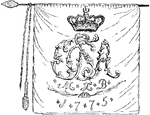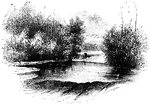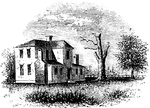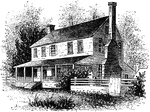
Grafton Occupied by Federal Troops
"View of Grafton, West Virginia, occupied by the Federal Troops, under the command of General McClellan,…

Railroad at Grafton
"View of Grafton, West Virginia, occupied by the Federal Troops, under the command of General McClellan,…
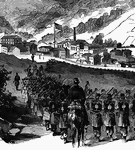
Federal Troops at Grafton, West Virginia
"View of Grafton, West Virginia, occupied by the Federal Troops, under the command of General McClellan,…
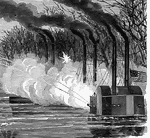
Bombardment of Fort Henry
"Bombardment of Fort Henry, Tennessee River, Tenn., by the Mississippi Flotilla, Flag Officer Foote,…

Bombardment of Fort Henry
"Bombardment of Fort Henry, Tennessee River, Tenn., by the Mississippi Flotilla, Flag Officer Foote,…
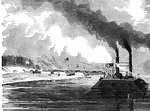
Bombardment of Fort Henry
"Bombardment of Fort Henry, Tennessee River, Tenn., by the Mississippi Flotilla, Flag Officer Foote,…
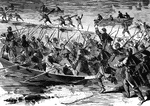
The Forlorn Hope
"'The Forlorn Hope.' Volunteers storming party, consisting of portions of the Seventh Michigan and Nineteenth…

The Forlorn Hope
"'The Forlorn Hope.' Volunteers storming party, consisting of portions of the Seventh Michigan and Nineteenth…

Battle of Chancellorsville
"Battle of Chancellorsville, Sunday, May 3rd, 1863. General Hooker repulsing the attack of the enemy.…
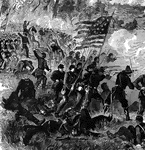
Battle of Chancellorsville
"Battle of Chancellorsville, Sunday, May 3rd, 1863. General Hooker repulsing the attack of the enemy.…
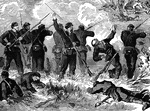
Battle of Chancellorsville
"Battle of Chancellorsville, Sunday, May 3rd, 1863. General Hooker repulsing the attack of the enemy.…
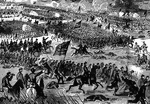
Battle of Champion Hills
"Battle of Champion Hills, May 16th, 1863- the formidable position of General Pemberton carried by Generals…

Battle of Champion Hills
"Battle of Champion Hills, May 16th, 1863- the formidable position of General Pemberton carried by Generals…
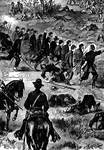
Battle of Champion Hills
"Battle of Champion Hills, May 16th, 1863- the formidable position of General Pemberton carried by Generals…
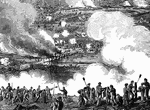
Battle of White Oak Swamp Bridge
"Battle of White Oak Swamp Bridge, Monday June 30th, 1862- Ayres's, Mott's and Randall's batteries checking…

Battle of White Oak Swamp Bridge
"Battle of White Oak Swamp Bridge, Monday June 30th, 1862- Ayres's, Mott's and Randall's batteries checking…
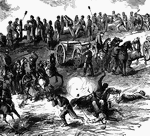
Battle of White Oak Swamp Bridge
"Battle of White Oak Swamp Bridge, Monday June 30th, 1862- Ayres's, Mott's and Randall's batteries checking…
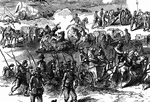
Battle of White Oak Swamp Bridge
"Battle of White Oak Swamp Bridge, Monday June 30th, 1862- Ayres's, Mott's and Randall's batteries checking…
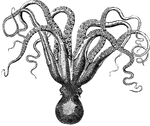
Cuttlefish
"It has no shell, and no skeleton, but has two conical pieces of horny substance imbedded in the back,…
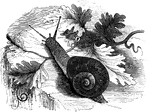
Common snail
"This is furnished with four tentacula, two of which are smaller than the others; at the end of these,…
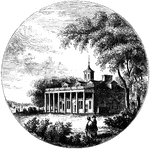
Mount Vernon
"Mount Vernon. This view is from the lawn in front, looking down the Potomac. The mansion is built of…
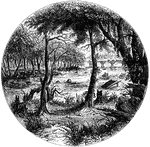
James River
"Scene on the James River, at Richmond. This view is from a long shaded island extending up the river…

Jamestown Island
"Distant view of Jamestown Island. This view is from the north side of what was once a marsh, but now…
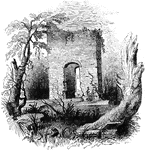
Jamestown Ruins
"Ruins at Jamestown. This view is from the old church-yard, looking toward James River, a glimpse of…
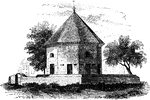
Old Magazine
"The Old Magazine. This view is from the square, looking southeast. South of it is a neat frame building,…

Apollo Room
"The Apollo Room. The room used for public meetings is in the rear building of the old Raleigh tavern…

Raleigh Tavern
"Raleigh Tavern. When I visited Williamsburg in December, 1848, the front part of the old Raleigh tavern…

Nelson Tombs
"The Nelson Tombs. This view is from the burial-ground looking down the York River toward Chesapeake…
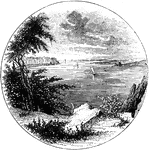
Redoubt
"View from the site of the Redoubt. This view is from the mounds looking northwest, up the York River.…
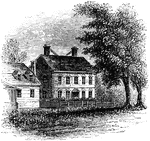
Nelson Mansion
"The Nelson Mansion. This view is from the street looking northwest. A long wooden building, with steep…
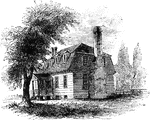
Moore's House
"This is a view from the lawn, looking south. It is a frame building with a brick foundation. At the…

Monticello
"Monticello, Governor Jefferson's place of retirement. This venerated mansion is yet standing, though…

Tryon Palace
"Front view of Tryon's Palace. The view here given was the north front, toward the town. The center…
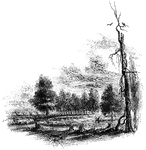
Regulator Battle-ground
"The Regulator battle-ground. This view is from the south side of the Salisbury Road, which is marked…

Ear-shell
"In these, which are called Ear-Shells, the animal has a shrt muzzle and two branchial plumes;…
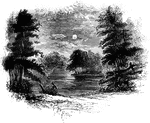
Trading Ford
"Trading Ford. This view of the Trading Ford, where greene, with Morgan and his light troops, crossed…

Guilford Battle-ground
"View of the battle-ground. This view is from the eminence southwest of the site of old Guilford Court…

Tuckesege Ford
"View at Tuckesege Ford. This view is from the western bank of the Catawba, looking down the stream."—Lossing,…
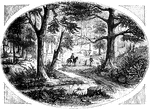
King's Mountain Battle-Ground
"View at King's Mountain battle-ground. This view is from the foot of the hill, whereon the hottest…
Eolis papillosa
"In these animals, which generally appear like small slugs, the branchiæ are arranged along on…
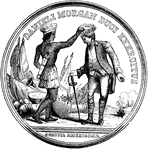
Morgan Medal Front
"Gold medal awarded to Morgan. The following are the devices and inscriptions upon the front of the…
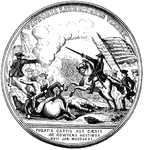
Morgan Medal Back
"Gold medal awarded to Morgan. The following are the devices and inscriptions upon the back of the medal:…
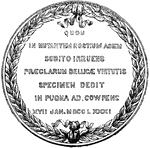
Howard Medal Back
"Silver medal awarded to Colonel Howard. The following are the device and inscriptions upon the back:…
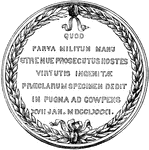
Washington Medal Back
"Silver medal awarded to Washington. The following are the device and inscriptions on the back: Quod…
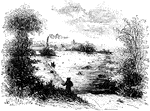
Cherokee Ford
"View at the Cherokee Ford. This view is from the east bank of the river. Toward the extreme right is…
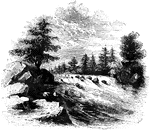
Catawba
"View of the Great Falls of the Catawba. This view is from the west side of the Catawba, looking northeast,…

Rocky Mount
"View at Rocky Mount. This view is from the garden-gate at Mrs. Barkley's, looking northeast. On the…

Rugeley's
"View at Rugeley's. This view is from the south side of the bridge. The counterfeit cannon was placed…

Sander's Creek
"View at Sander's Creek. This view is from the north side of the Creek. like the other stream, it is…

Hobkirk's Hill
"View at the Spring; Hobkirk's Hill. It is at the hed of a ravine, scooped out of the northeastern slope…
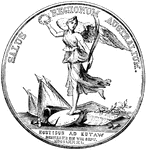
Greene Medal Back
"Gold medal awarded to Greene. This is a representation of the back side of the medal, the full size…
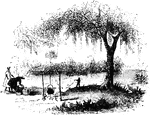
Nelson's Ferry
"View at Nelson's Ferry, the spot here portrayed, was an important locality during the Revolution. It…
!["View from the site of Fort Cornwallis. Fort Cornwallis occupied the ground in the rear of the Episcopal church, now a grave-yard. This view is from within the inclosure, looking northeast, and includes a portion of Schultz's bridge, the Savannah River, and Hamburg upon the opposite bank. In the foreground is seen portions of the church-yard wall, and upon the brink of the river below are [African Americans] employed in placing bales of cotton upon the wharves for transportation to the sea-coast. The wharves are two stories in height, one to be used at low water, the other when the river is 'up.' There were remains of the ditch and embankments of the fort within the grave-yard when I was there; and the trench leading to the water-gate, where the 'Pride-of-India tree is seen, was very visible."—Lossing, 1851](https://etc.usf.edu/clipart/14100/14143/ft-cornwalli_14143_mth.gif)
Fort Cornwallis
"View from the site of Fort Cornwallis. Fort Cornwallis occupied the ground in the rear of the Episcopal…

